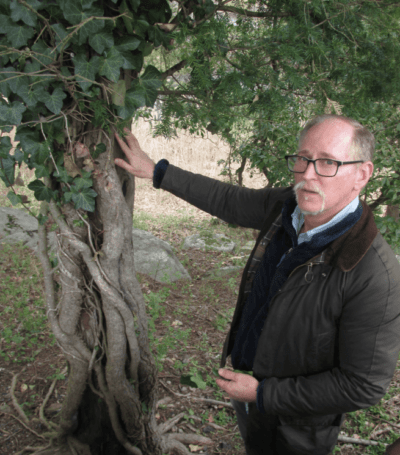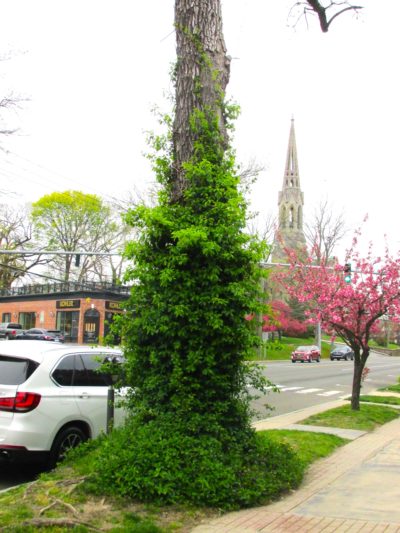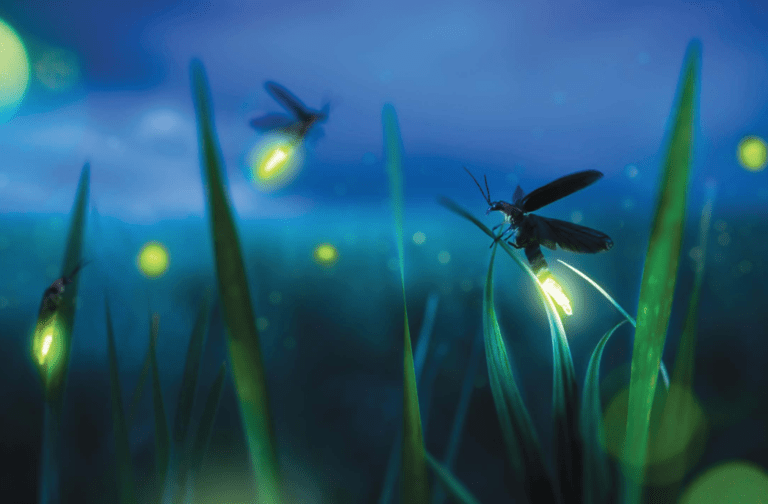On my watch – Ivy is strangling our beloved trees when we so badly need them in our changing climate
By Anne W. Semmes

I am a tree lover with growing concern for the preponderance of ivy found choking our trees. Yes, English ivy is a pretty thing when it climbs our stone walls or enhances our ivy league colleges.
But too often I see beloved trees about town slowly being engulfed by vines, especially the old oaks, while younger trees are beginning to wither. It’s time to seek the counsel of our town’s Tree Warden, Greg Kramer.
“There’s actually two evergreen vines that we’re battling right now,” says Kramer, “and one of them is certainly English ivy, and the other is Creeping Euonymus. It acts very similar to ivy. It has a small leaf and looks quite similar. It is a newer invasive in the last 10 years and it’s become more prevalent.” Kramer indeed is seeing our trees more choked with ivy or that other invasive more than he wants to see. He hypothesizes our winters have gotten milder and those ivy vines “don’t burn anymore and they mature and are setting fruit.”
At the Pinetum Kramer shows me how the ivy fruits itself. A Taxus Yew evergreen tree is embedded with thick ivy vines. He opens my eyes that there are two different ivy leaves: the leaf we can all recognize as the immature leaf and the mature leaf form that begins to grow outward in its climb. “What we’re seeing above us is it’s reached the canopy,” he points, “[The ivy] has changed form and this is all the reproductive part. So, if we came back in the fall, you’ll see blooms on the ends of all these mature leaves and then you’ll see fruit, little purple berries.” And the birds love those berries, with their ivy seeds inside, and “They fly around and do their business. And suddenly you find a little ivy seedling coming up where there wasn’t one before.”
So, do the ivy and the Creeping Euonymus often grow on the same tree? He’s seen both growing on the same tree. “There’s a trail on the Pomerance property called the Red Trail,” he tells. “At the very end of the trail there’s some big trees with both ivy and a lot of Euonymus growing together on them. And they do compete.” And yes, he sees the Euonymus growing faster.
“And just like the ivy it has an immature leaf and a mature leaf that’s crawling up the tree, and then once it reaches a certain height, it expands outward, becomes very woody, flowers, and then produces orange berries instead of purple berries.”
So, are these two vines more damaging to deciduous trees or evergreen trees? “That’s a good question,” Kramer responds. He believes these vines are “more detrimental to evergreen trees because they’re not quite as strong as a softer wood. And the trees I’ve seen that have come down seem to be evergreen trees. I’ve seen pine trees come down – I’ve seen Hemlock trees come down. The bigger deciduous trees with their harder wood seem to be able to handle vines a lot better.”
So, how long does it take for these vines to kill a tree. “I would say 20-30 years is a fair number before it really impacts a larger tree. The bigger, sturdier oak trees seem to manage it much better, and the maples, and certainly the conifers. Elm trees I’ve seen have it and they seem to be okay.”
So, how does one get rid of these vines? “Any time of year is good to cut. But if it’s a big, mature vine, certainly it’s best to cut before the vine sets fruit in September and October. So late spring or the summertime. And at this point in time, it’s easy to just pull out the vines at the base by hand because it’s small, like maybe six to eight inches crawling on the ground.”

But with this vine-imprisoned Taxus yew tree before us he says, “You can’t remove the ivy vines, or you would damage the bark of the tree because it’s almost grafted to the wood of the tree. So, at this point, the best thing to do is to cut at the base, let it dry for a season and then start to peel it off. Try to slowly pull off some of the extremities at the top, bring it down as far as you can without damaging the bark.”
So, what is the role of the Tree Warden to address these invasive vines? “We are starting to remove ivy from the Pomerance property, and particularly in natural areas, and when we see it right away we’re starting to cut it. Our staff and volunteer groups are starting to cut the bigger vines.” Here in the Pinetum he says its staff is addressing these vines. “It’s a challenge as there’s a lot of this here, and people like it because it’s green in the winter and does attract a lot of birds. The birds love the fruit.”
“Trees, importantly old trees,” Kramer reminds, “sequester carbon. Some of the oaks have hundreds of years of carbon. So, if you cut a tree down, a kind of live oak or a white oak or something of a substantial size and you burn it or it rots in the woods, it’s releasing carbon that was sequestered maybe 200 some odd years ago…So it’s actually adding carbon back into the system that was taken out of the system years ago.” Further to his dismay, and mine, he adds, “The clear cutting we are seeing across Greenwich is disastrous for the carbon situation.”
So, is it through the leaves that the carbon goes into the tree? “It’s through the leaves and also its lenticels [raised pores]. They breathe through their trunk as well. And one thing to always consider is trees are respirating at night so they’re not sequestering carbon, they’re actually respirating. They’re like us at night. They’re breathing out carbon dioxide and breathing in oxygen. It’s only during the day that trees take in carbon dioxide and release oxygen when they’re producing sugars.”
But, returning to the plight of our choked trees he tells of having been in Florida for half a dozen or so years then returning one winter. “And I was driving along some of the parkways and highways and seeing trees covered in ivy and I was just shocked at how much ivy there was from the time I lived in New York.” And then last Saturday he tells of taking a hike “in a fairly natural area with very little invasives and sure enough during my hike I come across trees in the middle of the woods with ivy on them. And there wasn’t ivy there two years ago, three years ago. It’s crazy.”





